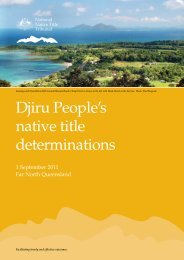Biodiveristy_State of Environment report - Mission Beach Cassowaries
Biodiveristy_State of Environment report - Mission Beach Cassowaries
Biodiveristy_State of Environment report - Mission Beach Cassowaries
- No tags were found...
Create successful ePaper yourself
Turn your PDF publications into a flip-book with our unique Google optimized e-Paper software.
The further effects <strong>of</strong> these scenarios are currently underresearch, by bodies such as Rainforest CRC, CRC Reef andAIMS.ConditionClimate change has not progressed to a stage where thereare obvious effects on biodiversity on land in the Shire,although coral bleaching on the reef is a phenomenoncurrently under investigation. Some species such as frogs inthe Shire may be being affected by pollution, but this is notyet determined to be an important component <strong>of</strong> frogdecline in the Wet Tropics.ResponseCurrent responses to climate change and pollution arediscussed in the Water and Atmosphere chapter.2.2 Flora2.2.1 Rainforest DiebackPressurePhytophthora cinnamomi is a fungus-like organismresponsible for extensive forest dieback in southern andwestern Australia. It is also a serious economic threat to theforestry and agricultural industries. It is estimated that up to14% <strong>of</strong> the Wet Tropics rainforest is potentially at risk, asthe fungus is mainly found on granite soils at high altitudes.Two hundred patches have so far been identified in the WetTropics, but the disease has not caused any major ecologicaleffects so far.ConditionWhile Phytophthora cinnamomi is present in the rainforestand is associated with many small notches <strong>of</strong> deadrainforest, it’s not yet known whether the organism poses aserious threat to the Wet Tropics. Research is under way atthe Rainforest Cooperative Research Centre, with supportfrom the Wet Tropics Management Authority (WTMAWebsite, 2005a).ResponseSo far studies have found significant correlations betweenthe human walking tracks and roads and distribution <strong>of</strong> thefungus. Management in the WHA will entail improvingdrainage, and restricting access along roads and trackswhere there is potential for infected soils to be picked up.Feral pigs and native animals are also considered to bevectors in movement <strong>of</strong> the disease, but the main cause atpresent is soil movement through attachment to footwear oron vehicles. QPWS and the WTMA can control potentialmovement <strong>of</strong> the disease by closing walking tracks androads where necessary.2.2.2 Threatened FloraThere are a number <strong>of</strong> threatened floral species present inthe Shire. A list <strong>of</strong> these species is included in Appendix 6.2(CD and Web version only). The appendix describes theirclassification under the Nature Conservation Act 1992 andthe <strong>Environment</strong> Protection and Biodiversity ConservationAct 1999.PressuresPressures on rare and threatened flora are assumed to bebasically the same as for the regional ecosystems <strong>of</strong> whichthey are part. No specific pressures are known for anyparticular species in the Shire, but this is due to the lack <strong>of</strong>data.ConditionUnfortunately there is no real data available on the actualdistribution <strong>of</strong> any endangered plant species. Potentialranges according to ecosystem type can be projected, but itis not known how rare and threatened floras in the Shire arefaring over time.Considering the complexity and variety <strong>of</strong> the rainforest it islikely that the full diversity <strong>of</strong> flora in the Shire has not evenbeen completely described.ResponseAn effort to describe the range <strong>of</strong> rare or threatened speciesshould be conducted over time. The distribution <strong>of</strong>important species in key areas should be monitored.Currently, threatened flora species are managed throughprotection <strong>of</strong> the regional ecosystems.Council is able to propagate threatened species and utilisethese in revegetation where appropriate.Rec: QPWS continue to collate data on distributions andmonitor threatened flora - QPWSRec: The Community Revegetation Unit collect seed andpropagate endangered species for inclusion inrevegetation work in appropriate areas - Council49



